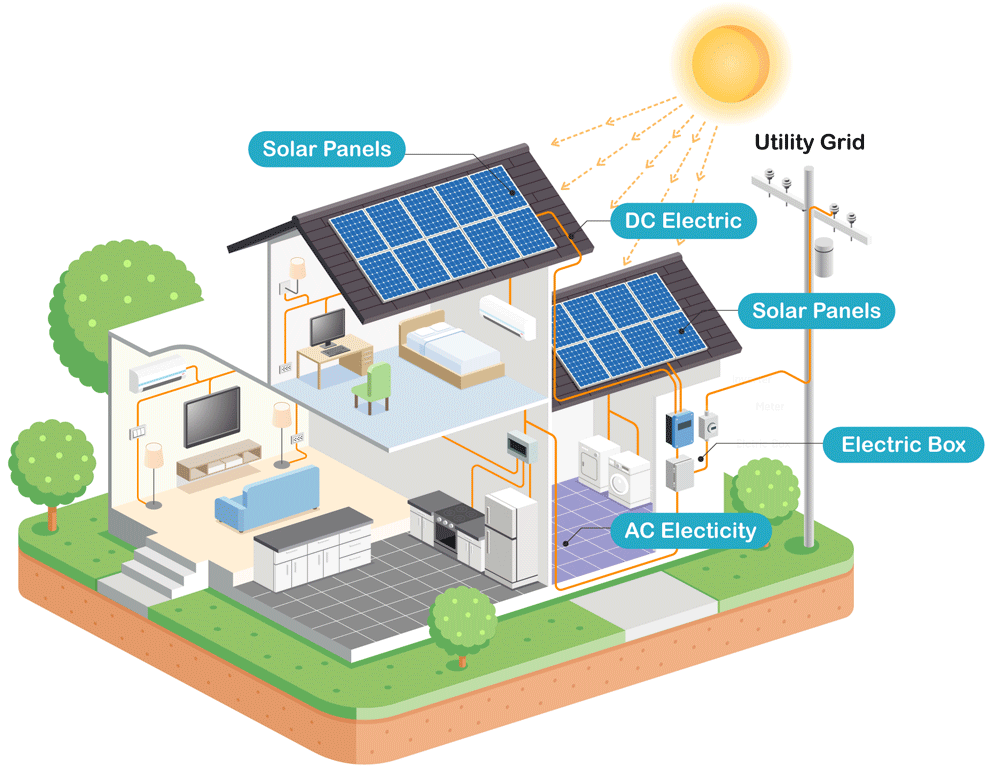
HOW SOLAR ON-GRID SYSTEM WORKS ?
1) Sunshine Hits the Panels
Sunlight causes electrons to move through the wiring connecting your home’s solar photovoltaic panels, creating direct current (DC) electricity. Grid-tied solar arrays require no batteries, no complex wiring, and no moving parts. Instead, they inter-tie directly with the grid (hence the name) allowing you to use the grid itself as a big battery.
2) A solar inverter converts DC power into AC power
The DC electricity produced by the solar panels is inverted into alternating current (AC) electricity that can be used in your home. The AC electricity flows into your circuit panel and is available for any active electric loads: lights, television, computers, refrigerator, electric vehicle, etc.
3) Excess power is sent to the grid
If your solar energy production exceeds your demand, then the extra solar electricity is pushed from your home out to the grid. A separate meter tracks this exported electricity. Called net metering, at the end of the month the utility will reconcile the difference between your solar production vs. electrical consumption, and you either earn a credit or are billed accordingly. Earned credits carry forward up to a year. Retail net metering is currently protected and accessible for new customers in all the states where we offer service: PAN INDIA
As per our experience with more than 100 projects the average generation per KW is 4.2 units per day., considering 300 sunny days in a year.so our 1 KW system will generate 1260 Units in a year for sure.
If you go for 10 KW than yearly generation will be 12600 units.
What Happens When the Power Goes Out?
Inverter that we install comes with an Is-landing feature, which disconnect the inverter automatically if there is a power cut, as it will save the electrician from the electric shock, who is working on the grid.
In the mean time, system will not produce any electricity.
Because grid-tied systems are grid-dependent, they will shut down when the connection to the utility is lost (this is a safety regulation that prevents PV systems from accidentally backfeeding and injury utility line workers). However, if you wish to maintain electricity in the event of a power outage, the ability to integrated battery storage with a grid-tied PV array is possible.
Does Solar Work in Winter?
It absolutely does. Shorter days and tougher weather won’t stop your system from working in winter. We at Lumen City have been installing solar arrays in India for over 8 years and have plenty of experience with designing solar arrays to endure everything winter can throw at them, from incredible cold to stacks of snow.
Why Invest in Solar Energy?
Lets understand it with a topic of Finance,” income“.
- There are three types of income.
- A) Active Income :Income for which services have been performed. This includes wages, tips, salaries, commissions etc. We need to pay tax on our income to government.
- B) Portfolio Income : An income that we generate by selling items, like stocks,property,goods etc . The profit that we generate comes in portfolio income, We need to pay tax on our profit
- C) Passive Income : This income makes you rich, as this incomes comes from your assets, like you rent a property,taking royalty on patents etc.
If you get a solar solution your saving will start from day 1, and you would be adding passive income to your pocket for coming years, where you do not have to pay tax at all.

